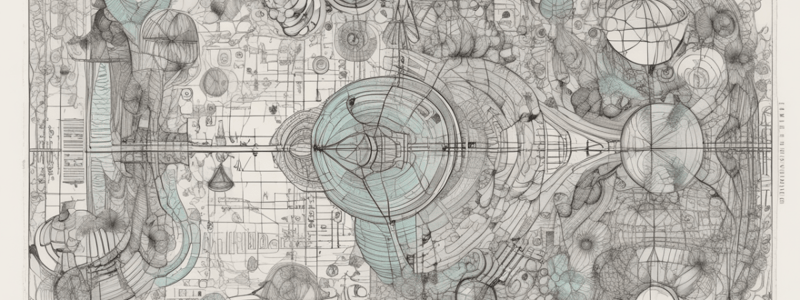Podcast
Questions and Answers
What is the primary advantage of using closed questions in data collection?
What is the primary advantage of using closed questions in data collection?
- They avoid interaction biases
- They provide detailed and qualitative insights
- They are easier to analyse and compare responses (correct)
- They are less time-consuming to answer
What can occur when a sample does not accurately represent the population?
What can occur when a sample does not accurately represent the population?
- Random sampling
- Research aim
- Population and sample
- Sample bias (correct)
What is the purpose of controlling for demographic factors in sampling?
What is the purpose of controlling for demographic factors in sampling?
- To select the population
- To determine the research aim
- To minimize sample bias (correct)
- To ensure sample bias
What type of question allows respondents to answer in their own words?
What type of question allows respondents to answer in their own words?
What is a limitation of using observation as a method of data collection?
What is a limitation of using observation as a method of data collection?
What is the primary disadvantage of using open-ended questions in data collection?
What is the primary disadvantage of using open-ended questions in data collection?
What is the purpose of a questionnaire in data collection?
What is the purpose of a questionnaire in data collection?
What influences the choice of the sample and the data collection method?
What influences the choice of the sample and the data collection method?
What is the main purpose of a line graph?
What is the main purpose of a line graph?
What is the formula to calculate the IQR?
What is the formula to calculate the IQR?
What is the main purpose of a histogram?
What is the main purpose of a histogram?
What is the main advantage of using anonymity in data collection?
What is the main advantage of using anonymity in data collection?
What is the primary purpose of classifying data?
What is the primary purpose of classifying data?
What is the median of a dataset with an even number of values?
What is the median of a dataset with an even number of values?
What is the purpose of a box and whisker plot?
What is the purpose of a box and whisker plot?
What is the main purpose of using tally marks?
What is the main purpose of using tally marks?
What is the main purpose of frequency tables?
What is the main purpose of frequency tables?
What is the definition of a percentile?
What is the definition of a percentile?
What is the purpose of a scatter plot?
What is the purpose of a scatter plot?
What is the definition of the mean in statistics?
What is the definition of the mean in statistics?
What is the main purpose of a bar graph?
What is the main purpose of a bar graph?
What is the main use of the median in statistics?
What is the main use of the median in statistics?
What is the formula to calculate the mean?
What is the formula to calculate the mean?
What is the main use of the mode in statistics?
What is the main use of the mode in statistics?
What is the purpose of the range in a dataset?
What is the purpose of the range in a dataset?
What is the definition of the range in statistics?
What is the definition of the range in statistics?
What is the purpose of quartiles in statistics?
What is the purpose of quartiles in statistics?
What is the purpose of organising data?
What is the purpose of organising data?
Study Notes
Developing Research Questions
- Open-ended questions allow respondents to answer in their own words, providing insightful and qualitative data.
- Advantages of open-ended questions: can yield detailed and qualitative insights.
- Disadvantages of open-ended questions: may be time-consuming to answer and analyze, and respondents might skip them if they take too long to answer.
- Closed questions provide predefined options for respondents to choose from, making it convenient and quick to answer.
- Advantages of closed questions: easier to analyze and compare responses.
- Disadvantages of closed questions: may not accommodate all respondents' views, leading to incomplete answers.
Collecting Data
- The research aim influences the choice of the sample and the data collection method.
- Population: the entire group from which data is collected (e.g., Gauteng Matric learners).
- Sample: a subset of the population chosen to represent it (e.g., learners from 10 schools in Gauteng).
- Sample bias: occurs when the sample does not accurately represent the population.
- Solution to sample bias: use random sampling to minimize bias, but still control for demographic factors such as race, gender, and age.
Methods of Collecting Data
- Observation: collecting data by watching and recording results without interacting with people.
- Advantages of observation: avoids interaction biases, useful for collecting behavioral data.
- Disadvantages of observation: limited to observable phenomena, does not capture respondents' attitudes or opinions.
- Questionnaire: a list of questions given to respondents to collect data directly from them.
- Advantages of questionnaire: anonymity can encourage honesty, suitable for large samples.
- Disadvantages of questionnaire: responses may be limited by the questions' design, lacks the ability to probe deeper into responses.
- Interview: an interviewer asks questions and records the responses.
- Advantages of interview: can clarify ambiguous answers, probe for more detailed information.
- Disadvantages of interview: time-consuming, may introduce interviewer bias.
Classifying and Organising Data
Organising Data
- Definition: arranging information into a specific order, such as ascending or descending order.
- Purpose: to make data easier to read and analyze by structuring it systematically.
Classifying Data
- Definition: grouping data into classes based on a common feature.
- Purpose: to simplify the data for better understanding and analysis by categorizing it into relevant groups.
Using Tally Marks
- Purpose: to count how many items fall into each category in an efficient and visually intuitive manner.
- Method: use vertical lines to represent counts, every fifth count is represented by a line crossing the previous four.
Frequency Tables
- Definition: a table that displays the frequency of various outcomes in a sample.
- Purpose: to show how often each category or group appears in the data set.
- Grouped Frequency Table: used for continuous data divided into intervals (e.g., height ranges).
Key Points to Remember
- Organising data helps to arrange information in a clear and systematic manner, facilitating easier reading and analysis.
- Classifying data involves grouping data based on shared characteristics, making it easier to handle and interpret large data sets.
- Tally marks are useful for counting discrete data quickly and efficiently.
- Frequency tables provide a clear summary of how often different values or ranges of values occur in a data set, making it easier to see the distribution and identify patterns.
Summarising Data
Measures of Central Tendency
- Mean (average): the sum of all values divided by the number of values.
- Use: provides a single value that represents the central point of the data set.
- Calculation: add all the values together and divide by the number of values.
- Median: the middle value in a data set when the values are arranged in ascending or descending order.
- Use: is less affected by outliers and skewed data than the mean.
- Calculation: arrange the data in order and find the middle value.
- Mode: the value that appears most frequently in the data set.
- Use: is useful for categorical data where we want to know the most common category.
- Calculation: identify the value that occurs most often.
Measures of Spread
- Range: the difference between the highest and lowest values in the data set.
- Use: provides a measure of how spread out the values are.
- Calculation: subtract the smallest value from the largest value.
- Quartiles: divide the data set into four equal parts.
- Use: help understand the spread and distribution of the data.
- Calculation: arrange the data in order, divide it into four equal parts.
- Interquartile Range (IQR): the range of the middle 50% of the data.
- Use: measures the spread of the central portion of the data.
- Calculation: subtract Q1 from Q3 (IQR = Q3 - Q1).
- Percentiles: divide the data set into 100 equal parts.
- Use: are used to understand the distribution of data and compare individual values to the entire data set.
- Calculation: identify the value below which a given percentage of the data falls.
Representing, Interpreting, and Analysing Data
Purposes of Graphs
- Graphs are used to visually represent data for various purposes, including:
- Exploring relationships
- Displaying and reporting
- Identifying patterns
Types of Graphs
- Line Graphs: show the relationship between two quantities over time.
- Features: data points connected by straight lines.
- Use: show trends and changes over time.
- Bar Graphs: represent data sorted into categories.
- Features: bars show the number of items in each category, with spaces between the bars.
- Use: compare different categories.
- Histograms: represent continuous data grouped into ranges.
- Features: bars touch each other, indicating continuous data.
- Use: show the distribution of continuous data.
- Scatter Plots: study the relationship between two variables.
- Features: each point represents a pair of values, showing patterns of correlation.
- Use: identify correlations between two variables.
- Pie Charts: show parts of a whole.
- Features: circular graph divided into sectors, representing percentages that add up to 100%.
- Use: compare parts of a whole.
- Box and Whisker Plots: summarize data distributions.
- Features: a box showing the interquartile range and whiskers extending to the minimum and maximum values.
- Use: summarize data distributions and identify outliers and spread.
Interpreting and Analysing Graphs
- Identify trends and changes over time in line graphs.
- Compare different categories in bar graphs.
- Identify the distribution of continuous data in histograms.
- Identify correlations between two variables in scatter plots.
- Compare parts of a whole in pie charts.
- Summarize data distributions and identify outliers and spread in box and whisker plots.
Studying That Suits You
Use AI to generate personalized quizzes and flashcards to suit your learning preferences.




